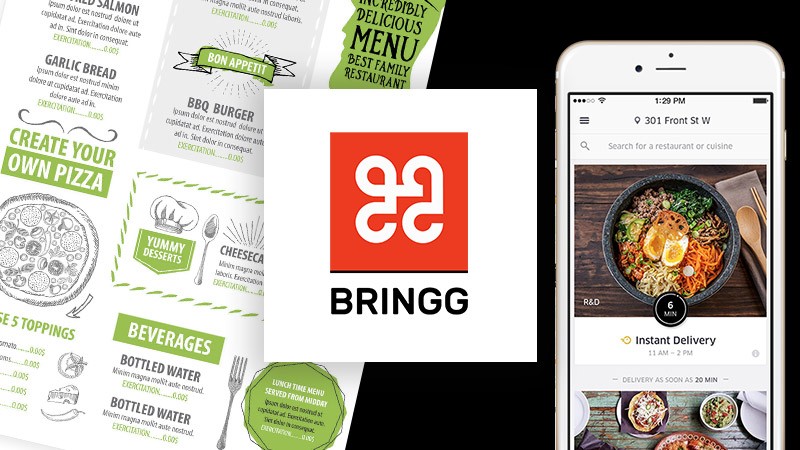Product Manager Yael Almog explains how Bringg’s menu distribution feature helps restaurants create a single source of truth and synchronize with aggregators.
Large restaurant chains maintain a centralized menu that’s integrated into their store operations and point of sale (POS) systems. However, keeping that menu up-to-date across multiple third-party eCommerce partners is challenging. Yael Almog, the veteran product manager who manages Bringg’s Menu Distribution feature, sat down to explain the service.
Why did Bringg decide to add this capability to its platform?
If you’ve ordered frequently from a restaurant, you’ve seen how their menus get updated regularly. Within a restaurant, everyone has access to the master data (the menu system), so updating menus across branches isn’t too difficult. But it gets complicated when you add in external sites where multiple restaurants list their menus.
These aggregators require the restaurant to update their menus; otherwise, the partner sites will unknowingly offer items that are unavailable, or list deals and combos which are not up to date.
Currently, many chains have to manually update their internal systems data, then update each of their eCommerce partners and check that their updates went through correctly. Oftentimes, we find that teams are maintaining multiple ‘sources of truth’: an Excel document, their systems data, and their POS or menu service, as well as multiple aggregators.
These manual processes are not only a waste of time, but they introduce the possibility of human error. For example, with one small slip, an order could be priced incorrectly, or may no longer even be available, even though it appears on the partner’s menu. This will inevitably disappoint customers, and lead to operational confusion when the orders are received by the restaurant.
These bad ordering experiences, are particularly risky for restaurants. The data shows that after just one bad experience, your customers will simply move to another restaurant and order from them.
“If restaurants want to ensure that customers get the best ordering experience possible, they need to nail the menu distribution process.”
Working with massive restaurant chains, many of which manage thousands of franchised locations listed across multiple aggregators, we saw the need to create a turnkey solution.
What does Bringg’s Menu Distribution do?
Bringg’s platform syncs with a restaurant’s centralized menu, and provides an easy tool for manually uploading menus if the restaurant’s backend cannot support this ability. Bringg then distributes and updates this menu across all relevant eCommerce partners.
It cuts down on the work and time needed, and significantly reduces the error rate and operational confusion.
Other than the operational benefits, the Menu Distribution feature enables marketing and business teams to communicate menu promotions and discounts, without having to spend the time manually consolidating it on all of the menus partner wide.
Let’s say the marketing department wants to run a ‘buy one, get one free’ sale. They can create a coupon or a serial number, both of which have to be generated in the POS, the first source of truth. Then, they need to add it to their files and distribute it to the partners. With Bringg, marketing or operations simply needs to update their POS. Bringg takes care of the rest.
What’s the greatest value that you see coming from the Menu Distribution feature?
In a nutshell, it streamlines all of the operations around menu distribution, avoids the operational nightmare of out-of-date menus, and thereby improves the customer experience.
“The menu distribution feature gives your brand greater reliability; in delivery, convenience and reliability are what drive customer loyalty.”
Operations and marketing consistently share that after implementing our Menu Distribution, they cannot imagine how they managed without it. As a product manager, this is the truest measure of success.
How fast is the menu update process?
It’s nearly instantaneous. It usually takes about a minute for our system to pull the menu from the restaurant’s POS, look for changes in prices or products, and send the update to partners.
What’s makes Bringg’s Menu Distribution feature unique?
Bringg is expert at translating restaurant menus and distributing it to all partners, either by using their API or by sharing an end point so they can take the menu and update it in real time.
Here’s what I mean:
Creating a public-facing menu often requires deploying advanced logical models that can break down and understand complex internal menus. For example, think about the sheer number of ingredients that can go into a ‘build-your-own-salad’ order, or a Lunch Combo Meal that can be comprised from a drink, a main dish and multiple side dishes. Each of these items can often be removed, replaced, upgraded or supersized.
We developed a platform that can analyze internal menus, and turn them into a clean and clear partner-facing format.
Our Menu Integration can also be easily customized to suit the needs of each restaurant. In one global restaurant chain, we were able to reduce POS errors and increase customer loyalty by making sure that menus and orders were synchronized. With this infrastructure in place, the restaurant was able to easily add on a major aggregator, substantially increasing their order volume.



